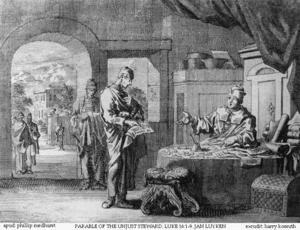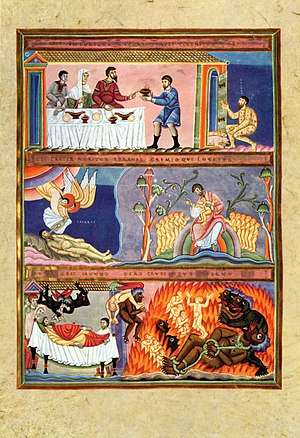Luke 16
Luke 16 is the sixteenth chapter of the Gospel of Luke in the New Testament of the Christian Bible. It records the teachings and parables of Jesus Christ, including the famous parable of the "rich man and Lazarus".[1] The book containing this chapter is anonymous, but early Christian tradition uniformly affirmed that Luke composed this Gospel as well as the Acts of the Apostles.[2]
| Luke 16 | |
|---|---|
 The Latin text of Luke 14:30–19:7 in Codex Gigas (13th century). | |
| Book | Gospel of Luke |
| Category | Gospel |
| Christian Bible part | New Testament |
| Order in the Christian part | 3 |
Text
The original text was written in Koine Greek. This chapter is divided into 31 verses.
Textual witnesses
Some early manuscripts containing the text of this chapter are:
- Papyrus 75 (AD 175-225)
- Codex Vaticanus (325-350)
- Codex Sinaiticus (330-360)
- Codex Bezae (~400)
- Codex Washingtonianus (~400)
- Codex Alexandrinus (400-440)
Parable of the Unjust Steward

This parable of Jesus appears in Luke, but not in the other Canonical gospels of the New Testament. It tells a story about a steward who is about to be dismissed, but curries favor with his master's debtors by remitting some of their debts. The New International Version calls this story "the parable of the shrewd manager".[3]
Verse 16
There is no verb in the original Greek: the word were is generally added to make sense of the sentence.[5] The ISV says they were fulfilled with John.[6] The NIV says they were proclaimed until John.[7] Matthew's text says:
- All the prophets and the law prophesied (επροφητευσαν, eprophēteusan) until John.[8]
Account of the Rich Man and Lazarus

Top panel: Lazarus at the rich man's door
Middle panel: Lazarus' soul is carried to Paradise by two angels; Lazarus in Abraham's bosom
Bottom panel: Dives' soul is carried off by two devils to Hell; Dives is tortured in Hades
The account of the rich man and Lazarus (also called the Dives and Lazarus or Lazarus and Dives) is a well-known teachings along with the parables of Jesus appearing in the Gospel of Luke. It tells of the relationship, in life and in death, between an unnamed rich man and a poor beggar named Lazarus. The traditional name, Dives, is not actually a name, but instead a word for "rich man",[9] dives, in the text of the Latin Bible, the Vulgate.[10] The rich man was also given the names Neuēs (i.e. Nineveh)[11] and Fineas (i.e. Phineas)[12] in the 3rd and 4th centuries.[9]
Along with the parables of the Ten Virgins, Prodigal Son, and Good Samaritan, it was one of the most frequently illustrated teachings in medieval art,[13] perhaps because of its vivid account of an afterlife.
The name Lazarus, from the Hebrew: אלעזר, Elʿāzār, Eleazar - "God is my help",[14] also belongs to the more famous biblical character Lazarus of Bethany, known as "Lazarus of the Four Days",[15] who is the subject of a prominent miracle attributed to Jesus in the Gospel of John, in which Jesus resurrects him four days after his death.[16]
See also
- Abraham
- Lazarus
- Ministry of Jesus
- Moses
- Parables of Jesus
- Other related Bible parts: Deuteronomy 1, Mark 10, Luke 4, Luke 24, Romans 7
References
- Halley, Henry H. Halley's Bible Handbook: an Abbreviated Bible Commentary. 23rd edition. Zondervan Publishing House. 1962.
- Holman Illustrated Bible Handbook. Holman Bible Publishers, Nashville, Tennessee. 2012.
- NIV subheading at Luke 16:1, accessed 30 June 2018
- Luke 16:16: NKJV
- Palmer, D. R., The Gospel of Luke: a Translation From the Greek, February 2018 edition, accessed 1 July 2018
- Luke 16:16: ISV
- Luke 16:16: NIV
- Matthew 11:13: NKJV
- Hultgren, Arland J (2002-01-01). The Parables of Jesus: A Commentary. pp. 110–118. ISBN 978-0-8028-6077-4.
- "Luke, chapter 16 verse 19". The Bible - Latin Vulgate. The Vatican. Retrieved 16 July 2013.
homo quidam erat dives et induebatur purpura et bysso et epulabatur cotidie splendide
- The Gospel According to Luke (I-IX). 1995-03-01. p. 1110. ISBN 978-0-385-52247-2.
- Fitzmyer IX, Ad populum I (CSEL 18.91), spelled Finees; and in Ps.-Cyprian, De pascha computus 17 (CSEL 3/3.265), spelled Finaeus
- Mâle, Émile (1961). The Gothic Image: Religious Art in France of the Thirteenth Century. p. 195.
- Barclay, William (1999-02-01). The Parables of Jesus. pp. 92–98. ISBN 978-0-664-25828-3.
- Gavrilova, L. V., From the History of Artistic Interpretations of the Biblical Story about the Lazarus Resurrection, Journal of Siberian Federal University, Humanities & Social Sciences 1 (2014 7) 20-29, accessed 2 July 2018
- Losch, Richard R (2008). All the People in the Bible: An A-z Guide to the Saints, Scoundrels, and Other Characters in Scripture. pp. 255–256. ISBN 978-0-8028-2454-7.
External links
- Luke 16 King James Bible - Wikisource
- English Translation with Parallel Latin Vulgate
- Online Bible at GospelHall.org (ESV, KJV, Darby, American Standard Version, Bible in Basic English)
- Multiple bible versions at Bible Gateway (NKJV, NIV, NRSV etc.)
| Preceded by Luke 15 |
Chapters of the Bible Gospel of Luke |
Succeeded by Luke 17 |